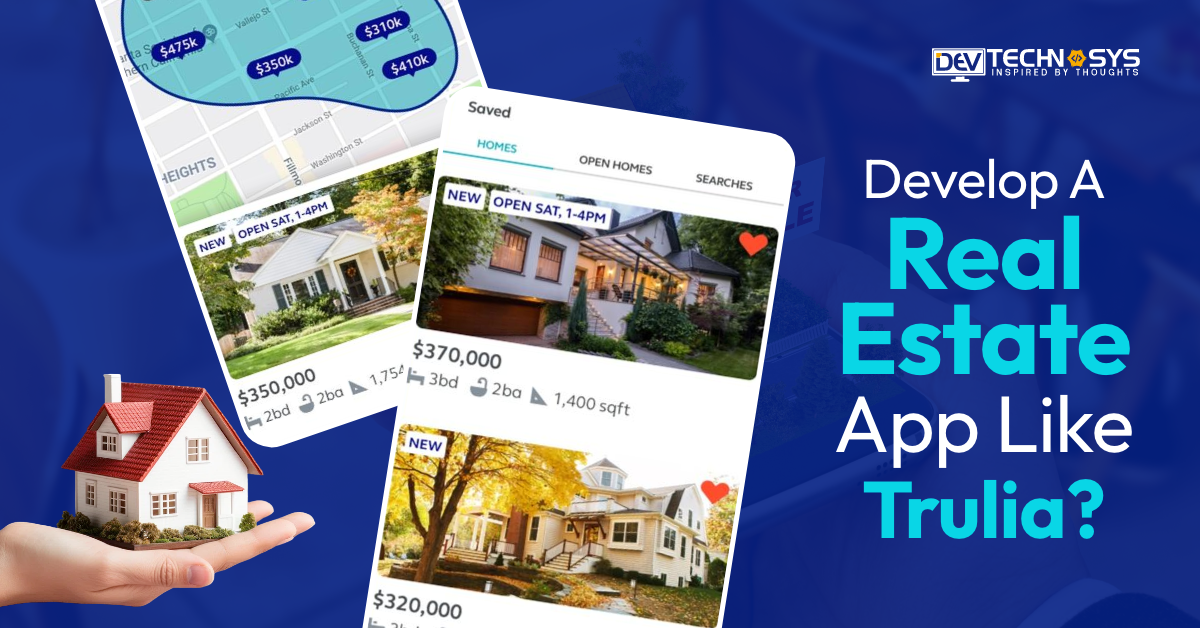We will take you on an exciting journey where technology meets vigilant supervision as we explore the costs and features of parental control app development. This blog will take you through the digital world, where parents try to empower their kids while protecting them from online dangers.
Be prepared to be enthralled by our decoding of the secrets behind creating a robust parental control phone app that combines cutting-edge technologies with user-friendly interfaces. We will uncover hidden gems, from budget-friendly features to custom solutions.
Join us as we unravel the mysteries of time management, content filtering, real-time monitoring, and more. Together, we will unlock the power behind Parental control app development and forge a path to a safer, more enriching digital future for our next generation. Join us on this journey today!
What is a Parental Control App?
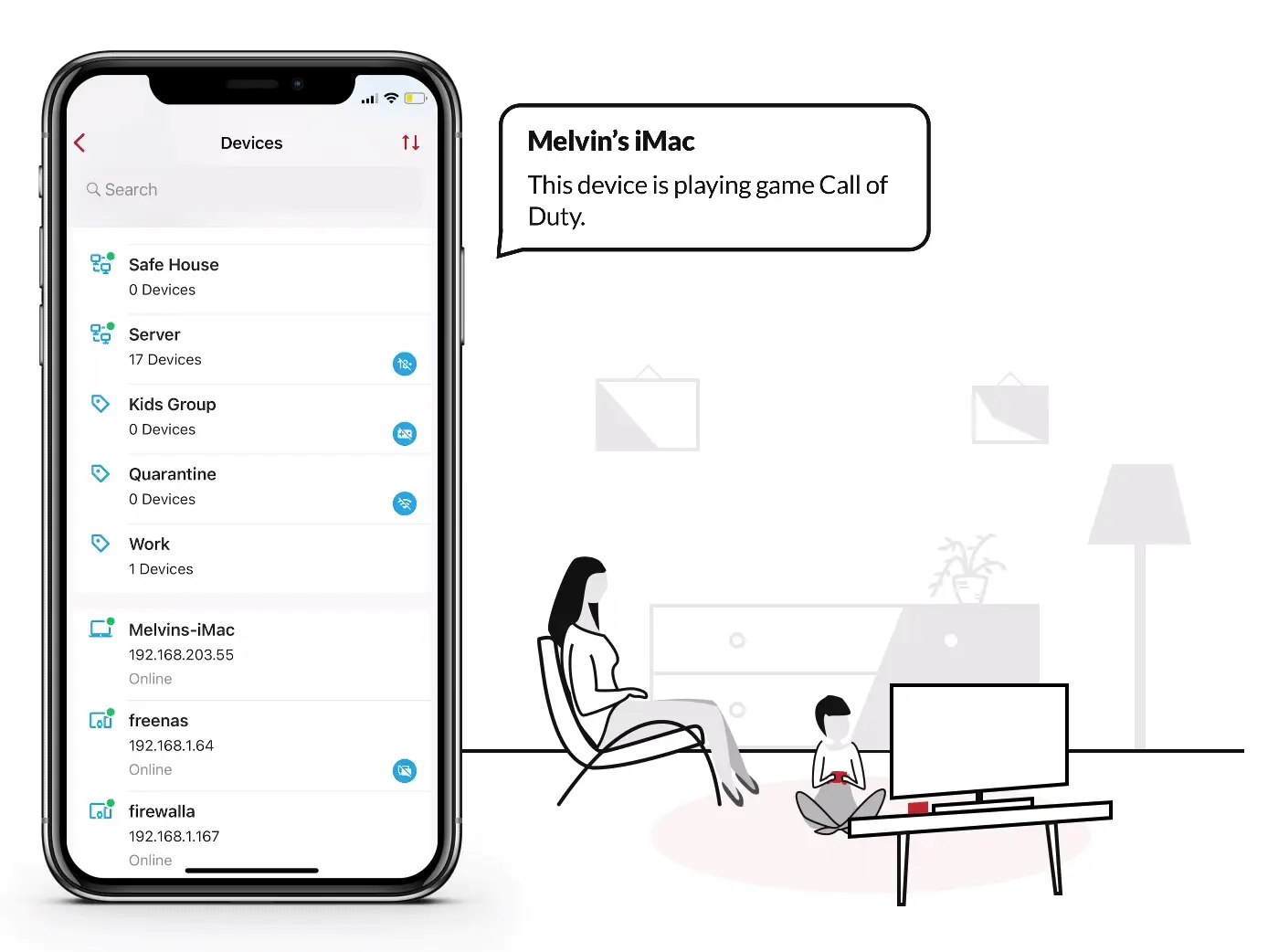
Parental Control apps allow parents to monitor their children’s online activities on a variety of devices and platforms. These apps have multiple features that ensure kids have a safe, controlled online experience. Parents can create filters that block inappropriate content, limit access to certain websites or apps and monitor their children’s internet usage.
It is vital to know that parents can also track their children using geofencing and location-tracking features in some parental control apps. The parents can also set screen limits with time management tools, which ensures a healthy balance of online and offline activities. Parental control app development protects children against online dangers and promotes responsible internet use.
How Does Parental Control Work?
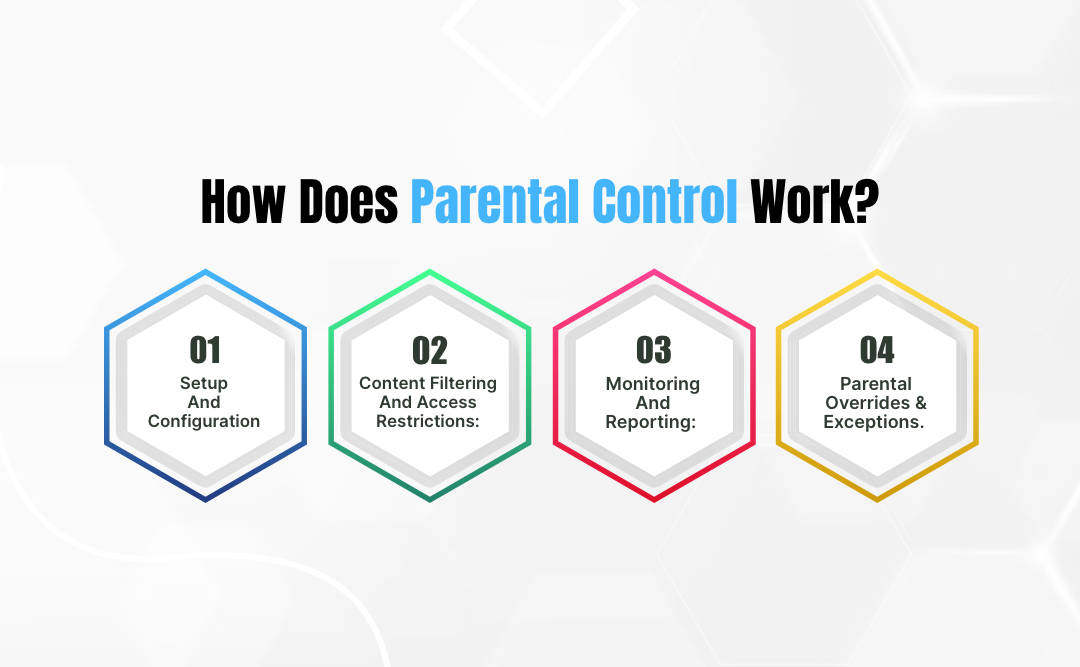
Parental control describes the tools and methods parents and guardians use to monitor and manage access to digital content, devices, apps, websites, and other applications. It is a simplified description of parental controls in four simple steps.
1. Setup And Configuration:
The first step is to install parental control software on the child’s device. You can do this by using the built-in features on your device (e.g., smartphones, tablets, or computers) or installing a third-party application. Parents can customize settings according to their child’s maturity level, age, and other factors.
2. Content Filtering And Access Restrictions:
After setting up parental control, parents can enable content filtering and access restrictions. Content filtering allows you to block or limit inappropriate websites, apps, and media using predefined categories or customized lists. Access restrictions include time limits, “bedtime hours” when the device locks, and restricting certain apps or features.
3. Monitoring And Reporting:
Many parental control programs include monitoring and reporting capabilities. Parents can view reports to gain insight into their child’s online activities. It has websites visited, used apps, and time spent doing various tasks. Some software sends parents regular email summaries or notifications about their child’s internet behavior.
4. Parental Overrides & Exceptions:
While parental controls are meant to enforce boundaries, exceptions may be necessary in certain situations. Specific parental control tools let parents temporarily grant access to blocked content or extend the screen time to meet particular needs. These parental overrides allow the system to be flexible and adaptable.
Top 8 Parental Control Applications
If you are looking for parental control app development then you must know some of its incredible competitors. In this section, we have compiled a list of the top 8 parental control app development that you must know about.
| Parental Control Application | Description | Ratings | Downloads (approx.) | Launch Year | Available Platform |
| Qustodio | Comprehensive parental control app with web filtering, time limits, monitoring, and app blocking. | 4.5/5 | 5 million+ | 2012 | iOS, Android, Windows, Mac |
| Norton Family | Allows parents to monitor and block websites, set time limits, and track search and social media activity. | 4.2/5 | 1 million+ | 2010 | iOS, Android, Windows |
| Net Nanny | Provides web filtering, app blocking, screen time management, and alerts on suspicious online activities. | 4.3/5 | 500,000+ | 1995 | iOS, Android, Windows, Mac |
| FamilyTime | Features include app blocking, geofencing, screen time limits, and location tracking. | 4.1/5 | 1 million+ | 2012 | iOS, Android |
| Bark | Detects cyberbullying, depression, and online predators by monitoring texts, emails, and social media. | 4.7/5 | 100,000+ | 2015 | iOS, Android |
| Mobicip | Offers internet filtering, time limits, and activity monitoring with real-time notifications. | 4.2/5 | 1 million+ | 2008 | iOS, Android, Windows, Mac |
| OurPact | Provides app and internet blocking, screen time schedules, and location tracking. | 4.3/5 | 500,000+ | 2013 | iOS, Android |
| Screen Time | Allows parents to set screen time limits, block apps, and track usage across multiple devices. | 4.1/5 | 100,000+ | 2012 | iOS, Android |
Features of Parental Control App
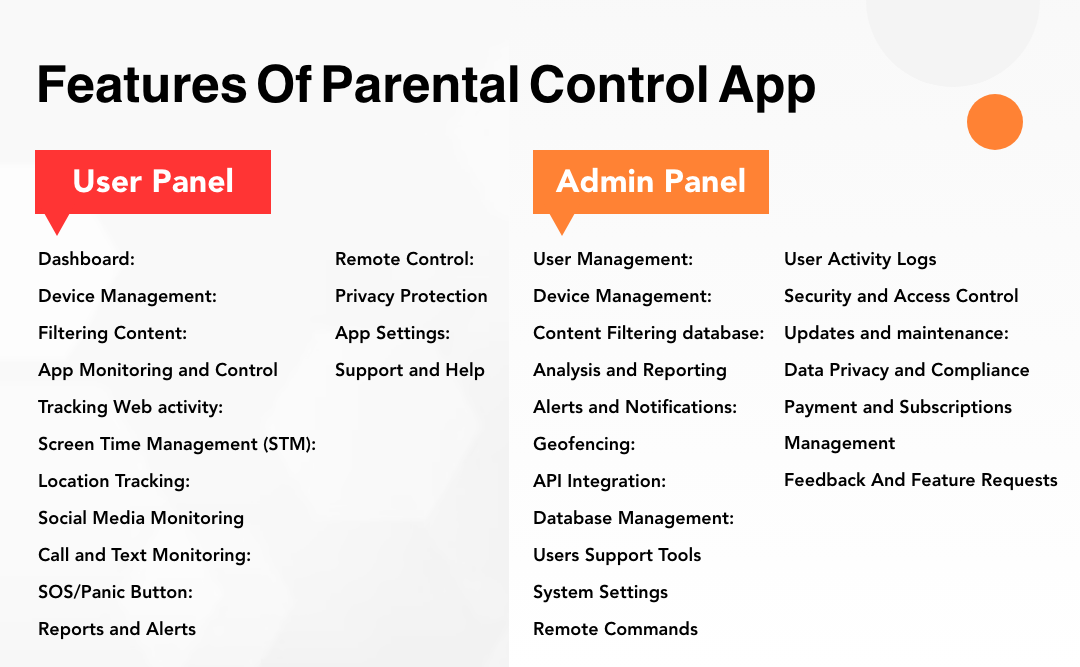
1. User Panel
It is most often necessary to create an interface that allows parents to manage and monitor their children’s online activities through parental control apps. These are the key features you’ll find in a user panel for a parental app.
- Dashboard:
The report provides a comprehensive view of the device activity, including information on recent app and online usage, sites visited, screen time, and other relevant data.
- Device Management:
It includes the ability to add devices, remove them, and manage their status. It includes smartphones and tablets, computers, consoles of gaming, etc.
- Filtering Content:
This feature allows parents to create filters blocking or restricting inappropriate content, apps, or websites based on age.
- App Monitoring And Control:
Parents can view and control the installed apps on their child’s devices. Parents can set time limits or block specific apps.
- Tracking Web Activity:
Recordings and reports of the websites a child visits allow parents to monitor their internet browsing history.
- Screen Time Management (STM):
Set time limits for your child to use devices and plan their usage, such as during bedtime or when they are studying.
- Location Tracking:
Tracking GPS to find the device of your child in real-time. This feature lets parents know where their child is and create geofences.
- Social Media Monitoring
Maintain an eye on your child’s social media activities, including post and message activity.
- Call And Text Monitoring:
You can access call logs, SMS messages, and contact lists for safe communication.
- SOS/Panic Button:
The child’s mobile device should have a dedicated button to alert the guardian or parent in an emergency.
- Reports and Alerts:
Reports that summarize the child’s activity online, their device usage, and attempts to access content are blocked. Alerts are a great way to notify parents about potential threats or violations.
- Remote Control:
Remotely lock or unlock a child’s mobile device or remotely wipe data.
- Privacy Protection:
Assure the privacy and security of data transmitted and collected between the child’s device and the user panel.
- App Settings:
Parents can customize the controls to meet their needs and preferences.
- Support And Help:
Parents can access customer service and resources to help them set up and use the Parental control app development.
2. Admin Panel
- User Management:
This feature allows admins to add, modify, or remove user accounts. This feature allows administrators to add, remove, or modify user accounts.
- Device Management:
Admins can monitor all devices connected to the on-demand app development and track their status, such as online/offline or device compatibility.
- Content Filtering Database:
Access a database containing websites, apps, and content categories to create and update filtering rules.
- Analysis And Reporting:
Tools for data analysis and reporting that offer insights into the user’s behavior, app usage, and content access attempts.
- Alerts And Notifications:
Alerts and notifications in real-time to alert administrators of critical events or policy violations.
- Geofencing:
Geofencing allows administrators to set geofences in specific areas and receive alerts whenever a child enters the site.
- API Integration:
Integration with third-party APIs or services for enhanced functionality and data sharing.
- Database Management:
Store and manage data securely, including device information, logs of activity, and other data.
- Users Support Tools:
Tools that help customer service representatives address user questions, technical issues, or problems.
- System Settings:
The parental control app development can be configured to perform specific actions, such as database updates, default policies, and system-level settings.
- Remote Commands:
Administrators can remotely send commands to devices linked for actions such as locking the device or initiating data wiping.
- User Activity Logs:
Logs detailing user activity include login history, configuration updates, and other admin actions.
- Security and Access Control:
Use security measures like role-based access controls (RBAC) to ensure appropriate access levels to different admin roles.
- Updates And Maintenance:
Tools can manage parental control app development updates, bug fixes, and maintenance tasks.
- Data Privacy And Compliance:
Features that ensure compliance with data privacy regulations and user privacy.
- Payment And Subscriptions Management:
The admin panel should manage subscriptions and payment processing if the parental control app development is subscription-based.
- Feedback And Feature Requests:
Apps that receive user feedback can be improved by incorporating bug reports and feature requests.
Cost of Parental Control App Development
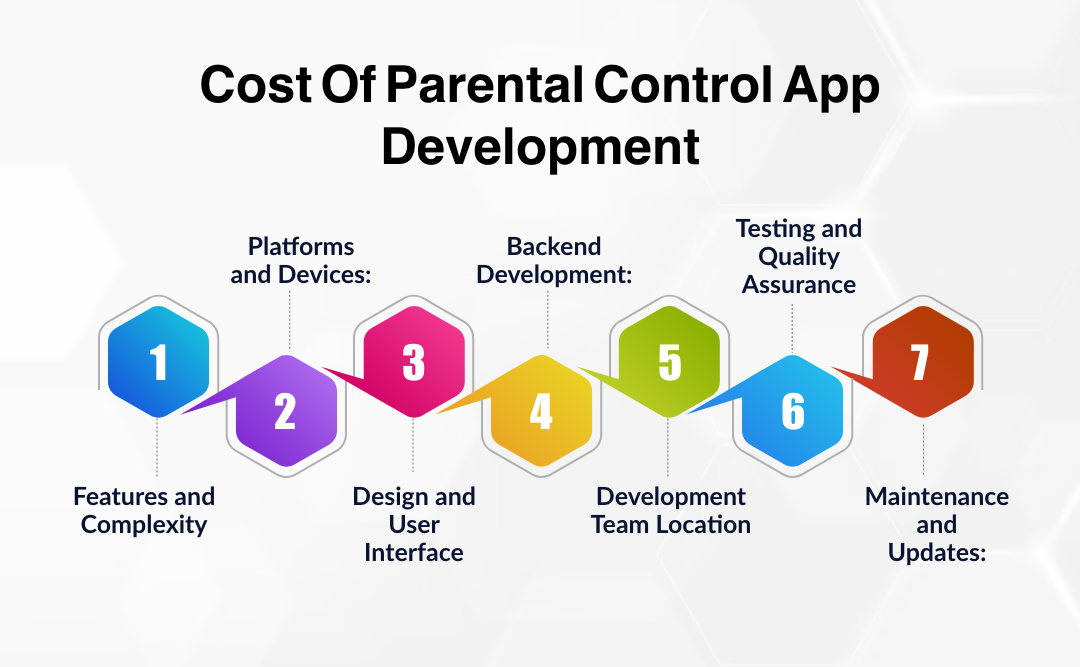
The cost to develop a parental app varies widely depending on several factors. In addition to the complexity of the app, its features, the platform it supports, and where the flutter app development company is located, there are other factors involved. Several factors can influence parental app development costs.
1. Features And Complexity:
The parental control app development will become more complicated and costly the more features you add. So, more than simple parental control apps with fewer features will likely cost less to develop than comprehensive solutions, including advanced features such as web filtering and geofencing.
2. Platforms And Devices:
Parental control app development can be created for different platforms such as iOS, Android, and even desktop or web. Each forum requires separate efforts for development, which can affect the cost.
3. Design and User Interface:
A user-friendly and intuitive design is essential for an app that controls parental access. Parental control app development cost can be affected by the complexity and quality of an app’s user interface.
4. Backend Development:
Apps will require a robust infrastructure in the backend to handle user accounts, store information, and communicate between devices. Costs can be affected by the complexity of a backend.
5. Development Team Location:
Mobile app development company hourly rates can vary greatly depending on their location. The overall development cost can be reduced when you hire android app developers in lower-wage regions.
6. Testing and Quality Assurance:
It is essential to ensure your app’s stability, security, and functionality through thorough testing and quality assurance. This process can add to the overall cost of parental control app development.
7. Maintenance And Updates:
Following the launch of the parent-guardian app, maintenance, updates, and customer service will be needed. But, it is essential to factor in these costs for the success of your parental control app development.
Here’s a table that gives you an idea of the cost range of parental control app development. Remember that these are just rough estimates.
| Development Cost | Approximate Range |
| Basic Features | $8,000 – $12,000 |
| Standard Features | $12,000 – $18,000 |
| Advanced Features | $18,000 – $25,000+ |
The actual parental control app development cost depends on your requirements and the approach you select. To get an accurate quote it is crucial to hire a react native app development company.
How To Develop a Parental Control App?
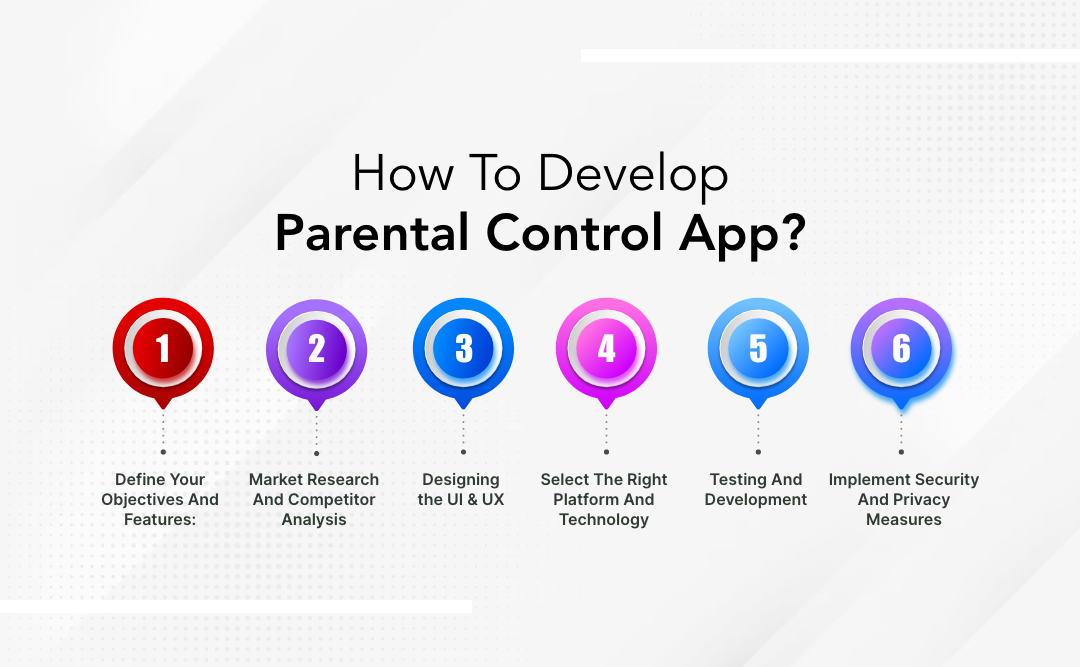
Custom parental control app development can be a complex process, but here are six general steps to guide you through the process:
1. Define Your Objectives And Features:
Define the goals of your ios parental control app. What are you hoping to achieve with it? Some of the most common features are website filtering and app blocking. Other features include screen time management, location tracking, and activity monitoring. You can prioritize features based on your target audience and your market research.
2. Market Research And Competitor Analysis:
Do thorough market research to understand better your audience, their requirements, and the competition. To identify strengths and weaknesses, analyze existing parental control applications. So, analyze feedback and customer reviews to determine what customers like and dislike about the current solutions.
3. Designing the User Interface (UI) and User Experience (UX):
Create an interface that’s easy to use and understand for parents and children. Consider the aesthetics, the layout, and the interactions to make the app appealing and intuitive. Well-designed UI/UX will have a significant impact on the success of your application.
4. Select the Right Platform And Technology:
Choose whether you’re going to build a parental control app for ios or Android. But, you must know that your app’s needs should be met with the right tools and technologies. Consider cross-platform frameworks or native development for more efficient parental control app development.
5. Testing And Development:
Begin the parental control app development process by referring to the technical and design specifications, dividing the parental control app development process into smaller sprints, and testing thoroughly after each sprint is a good idea. Therefore, test your parental control phone app on different devices to eliminate bugs and ensure compatibility.
6. Implement Security And Privacy Measures:
Security and privacy are paramount since parental control apps handle sensitive data. Encrypt data transmission and storage and ensure that user data is protected. So, comply with privacy regulations, and ensure the Google parental controls on the app are transparent about data collection and use.
Benefits of Parental Control App Development
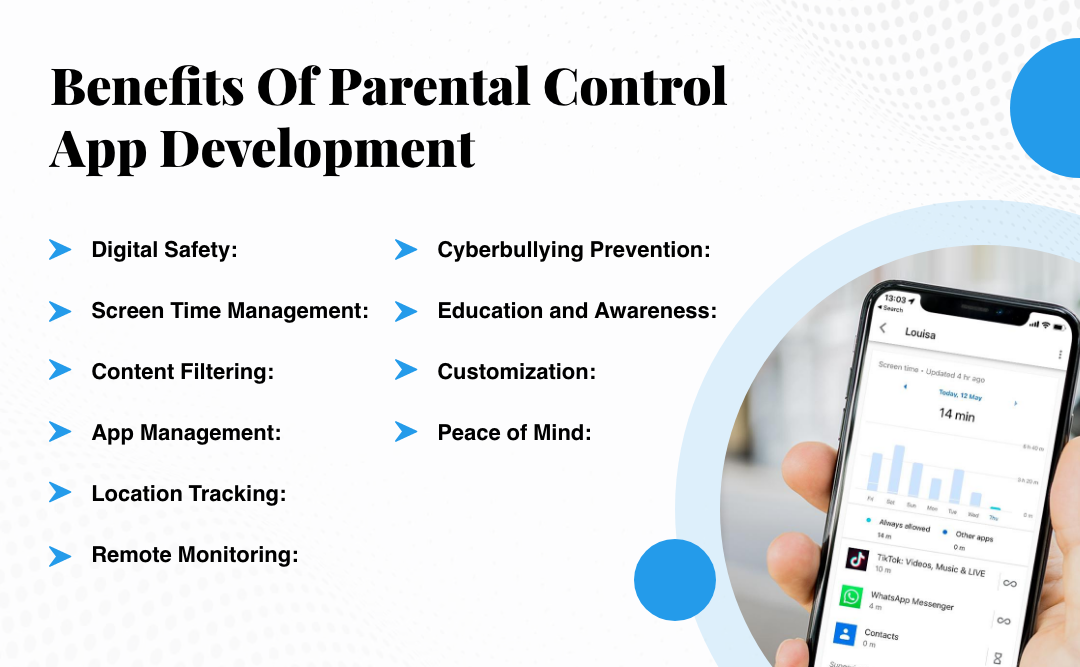
Parental control app development offers a range of benefits for both parents and children in today’s digital age. Here are some of the key advantages:
1. Digital Safety:
Parental control apps help ensure the online safety of children. They allow parents to monitor their child’s online activities, block inappropriate content, and limit access to potentially harmful websites, apps, or games.
2. Screen Time Management:
In addition to affecting a child’s physical health, excessive screen time can also negatively impact their mental health. By setting time limits on device usage, iOS parental control apps promote a healthy balance between screen time and other activities.
3. Content Filtering:
This parental control app for Mac often has content filtering features, allowing parents to block access to explicit or age-inappropriate content, including websites, videos, and apps.
4. App Management:
Parental control apps let parents control which apps their children can download and use, preventing access to apps that may not be suitable for their age.
5. Location Tracking:
Some parental control apps offer location tracking, allowing parents to track their child’s whereabouts. So, this feature can provide peace of mind and enhance safety, especially in emergencies.
6. Remote Monitoring:
Many parental control app for apple allows parents to remotely monitor their child’s activities, such as browsing history, app usage, and social media interactions. Hence, this feature enables parents to stay informed and address any potential issues proactively.
7. Cyberbullying Prevention:
Parental control apps can help identify signs of cyberbullying by monitoring online conversations and social media interactions. So, it enables parents to intervene and support their child experiencing cyberbullying.
8. Education and Awareness:
These free parental control apps often come with educational resources and insights for parents on digital safety and responsible online behavior. But you must keep in mind that this helps parents stay informed about the latest online trends and risks, allowing them to have informed conversations with their children.
9. Customization:
Best free parental control apps usually offer customizable settings, allowing parents to tailor restrictions and permissions based on their child’s age, maturity level, and individual needs.
10. Peace of Mind:
By having access to monitoring and control features, parents can feel more confident in their child’s online experiences, knowing they are taking necessary precautions to protect their well-being.
Takeaway!
We have concluded our journey into the world of on-demand parental control app development and are now aware of these apps’ vital role in protecting our digital natives. This journey has revealed the many available features to suit different budgets and needs. So, the need to protect children as technology advances is also increasing.
Let’s embrace powerful tools that empower parents to safely guide young explorers through the endless realms of the Internet. Together, we can create a more secure digital future with parental iOS App Development.
Frequently Asked Questions
Q1: How Much Does It Cost To Develop A Parental App On Average?
The cost to develop a parental monitoring app can range from $20,000 to $50,000, depending on its complexity and features.
Q2: What Features Are Essential To A Parental App?
It includes essential features like content filtering, blocking apps, screen time management, and location tracking.
Q3: Can A Parental App Be Customized For Specific Needs And Requirements?
Parent mobile apps can be tailored to meet specific needs, including age-appropriate restrictions and additional functionality.
Q4: What Is The Time Required To Create A Parental App?
A parent-child care app takes between 3 and 6 months to develop, including the design, testing, and development phases.
Q5: Do Parental Control Apps Require Ongoing Maintenance?
Maintenance costs range between 15% and 20% of the original development cost per year, typically for updates and support.















